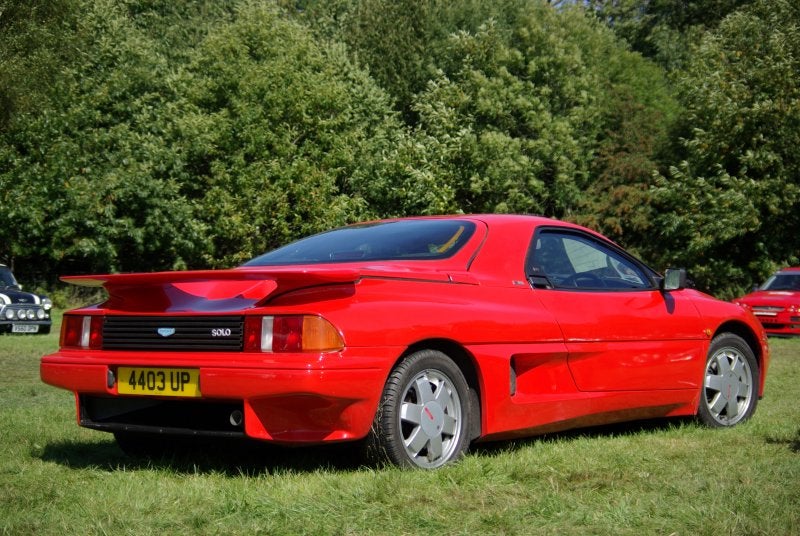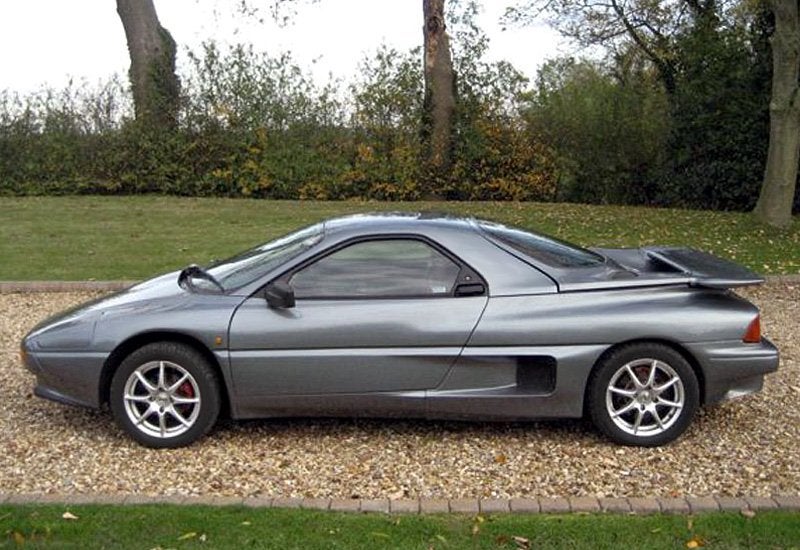 "F40LM" (mclarenf1gtr)
"F40LM" (mclarenf1gtr)
11/30/2013 at 17:59 • Filed to: CYDKA
 8
8
 4
4
 "F40LM" (mclarenf1gtr)
"F40LM" (mclarenf1gtr)
11/30/2013 at 17:59 • Filed to: CYDKA |  8 8
|  4 4 |
Cars You Didn't Know About: The Panther Solo 2

!!! UNKNOWN HEADER TYPE (MULTI-LINE BREAK?) !!!
I mean it was basically sports card Sierra RS Cosworth 2+2!
!!! UNKNOWN HEADER TYPE (MULTI-LINE BREAK?) !!!
When Autocar's Stephen Sutcliffe recalled his first test of the car in 1990, he wrote, "I couldn't believe how good to handle... A lot of feel and composure yet to be bettered by any mid-engined supercars, F355 included."
The then owner of Panther intended on building what he called a "mini-Ferrari". Prices were to start at £10,000 and top off at £14,000 for a turbo charged version.
Development was started in 1983. The first prototype was displayed one year later at the 1984 NEC London motor show. Here is that car, the Panther 1 (It is in fact a Targa):

It used the 1.6 out of the Escort XR3i (105HP) but was going to be available with the 130HP turbocharged unit from the Escort RS Turbo. Everything else pretty much was bolt-on from the Ford, except for the chassis. It had a steel box monocoque and a steel honeycomb rear bulkhead where the engine and suspension were mounted. The body consisted of glass fibre in some parts and aluminum panels above the belt line.
Toyota then released the infamous MR2 and scared the crap out of Panther. The owner of Panther drove the MR2 and was blown away by its performance, and at only £9300 Panther had to change direction of the near-complete Solo 1 in order to not be in direct competition with Toyota.
The Solo 1 was apparently cut up and re-purposed. The Solo 2 was delayed until 1989, it was supposed to cost £20,000 (which was still a lot cheaper than a Ferrari) but ended up jumping to £40,000; as much as an Esprit Turbo or a 911!

It's hotly debated exactly how many Solo 2's were produced, but it's fair to assume that 25 cars were produced. 12 customer cars, one demonstrator, one road test car, and the rest for crash testing and prototypes.

It now used the 2.0 Turbo 4 from the Sierra RS Cosworth, now developing 204HP and 199 IB/FT of torque. That's 185 BHP per tonne. The Solo's quoted weight was 1100 Kg but assumed much more due to its performance figures in comparison with the RS Cosy. It was still mid-engined, but now featured four wheel drive. The pop-up headlights were replaced with ones which rolled open on their longitudinal axis.


The central floorpan was a box-section structure fabricated from steel, but the survival cell was now reinforced by a composite body made of glass-fiber laminating aluminum honeycomb core. Some Kevlar and carbon-fiber were also employed to reinforce where extra strength was necessary. This advanced structure contributed to a torsional ridigity of 13500 Nm/degree, an unheard figure for its days. The Cosworth engine was now mounted North-South at a tubular steel subframe. The 5-speed gearbox located fore of the engine and inside the transmission tunnel. The Ferguson 4WD system was based on Sierra XR4x4 but it got a custom-made transfer box. Normal torque split was 33:67 front to rear so that it would not induce too much understeer like most 4WD vehicles. Both center and rear differential got viscous coupling to limit slippage. The suspensions were now made by Panther itself, using struts up front and double-wishbones at the rear. However, many other bits still came from Ford, such as the ABS (from Granada) and most of the interior's switch gears.

The chassis was also improved by March, which had wealth of knowledge building F1 chassis. As before, the central floorpan was a box-section structure fabricated from steel, but the survival cell was now reinforced by a composite body made of glass-fiber laminating aluminum honeycomb core. Some Kevlar and carbon-fiber were also employed to reinforce where extra strength was necessary. This advanced structure contributed to a torsional ridigity of 13500 Nm/degree, an unheard figure for its days. The Cosworth engine was now mounted North-South at a tubular steel subframe. The 5-speed gearbox located fore of the engine and inside the transmission tunnel. The Ferguson 4WD system was based on Sierra XR4x4 but it got a custom-made transfer box. Normal torque split was 33:67 front to rear so that it would not induce too much understeer like most 4WD vehicles. Both center and rear differential got viscous coupling to limit slippage. The suspensions were now made by Panther itself, using struts up front and double-wishbones at the rear. However, many other bits still came from Ford, such as the ABS (from Granada) and most of the interior's switchgears. For yo real number junkies: the front tires were 195/50VR15 and the rears were 205/50/VR15


It had an almost flat underbody and made use of functional diffusers and a spoiler, resulting in a drag coefficient of just 0.33 with positive downforce simultaneous at both ends.

The driving position was set far forward than many mid-engined sports cars, so the footwell was small and seriously offset to the center. Otherwise the cabin was quite practical to use. There was decent headroom, clear instruments and supportive Recaro seats. Access to the cabin was easy. Just don't expect the rear seats to be useable, even for children. Outside, the build quality was quite poor. Large assembly gaps and ill-fitted panels revealed the fact that Panther lacked resources to properly develop the car for full-scale production. The same could be said to its poor reliability. Imagine if it was built by Ferrari or Porsche, the story could be very different.

On the road, the Solo II was not as quick as expected. Autocar demonstrated the car from zero to 60 mph in 6.8 seconds and to the ton at just over 18 seconds, embarrassingly slower than the Sierra RS Cosworth with which it shared engine. This implied the car was likely to weigh a good deal more than its claimed 1235 kg. Top speed, however, was proved to be 144 mph on a banked track, so it was not far off the 150 mph claim. More worrying was the way the engine delivered performance – it revved and sounded coarse above 5000 rpm, lacking the eagerness that an expensive sports car deserved. It also showed too much turbo lag low down. The engine was simply not up to the level of the chassis.


On the plus side, the car displayed great handling. CAR magazine compared it with the very good !!!error: Indecipherable SUB-paragraph formatting!!! (already one of the best driver's cars ever made) and came out impressed with the Solo's communicative steering and superior maneuverability. Its 4WD generated a little initial understeer but it could be turned to controllable oversteer with throttle and steering. Sitting close to the front axle, the driver had a good sense of what the front wheels were doing, while the tail was always obedient. The handling was fail-safe, the grip tenacious (despite of small wheels) and the chassis delivered great feedback. The tester claimed no car could be more satisfying to drive on narrow, winding mountain roads, including the Lotus.

Nevertheless, to sell a £40,000 sports car of unknown brand and quality was just impossible then. It became obvious to Young Kim that he had no hope to recoup the investment made. In 1988, he sold Panther to Ssangyong before seeing the birth of Solo. 2 years later, the company ceased production in UK at all. Ssangyong produced a prototype called the Solo 3, and a racing version of that prototype called the Ssangyong Le Mans. BET YOU DIDN"T KNOW ABOUT THAT ONE!
Here's a shot of the prototype Solo 3:

It actually takes time to prepare these things, so if you like it - tell me, and i'll try and keep them coming. Thank for reading!
 daender
> F40LM
daender
> F40LM
11/30/2013 at 18:20 |
|
This is one car I wouldn't mind seeing the Chinese make if they keep the Solo true to it's origins but with a Japanese motor.
 SpeedSix
> F40LM
SpeedSix
> F40LM
11/30/2013 at 18:38 |
|
I knew about this car's existence, but this is way more information than I knew before. Nicely written!
 rig_pig
> F40LM
rig_pig
> F40LM
12/04/2013 at 23:46 |
|
Brilliant. Articles like this really get to my inner geek so yes, more please!
I do remember seeing pictures of the Solo back in the day but I had no idea of its power train's origins. If only a version was made with a BTCC spec RS500 lump........
 person
> F40LM
person
> F40LM
01/25/2015 at 14:08 |
|
when the solo was announced the car magazines thought it was the second coming, going as far as to say it was "the most important british sports car since the jaguar e type" and a "giant killer" those that didn't think it was the mechanical jesus still thought it needed to be on the cover and devoted large section of their magazines to it. The solo might be obscure if you're not into cars or you're too young but to everyone else it's a car that 1 they know and 2 evoques and emotional response that few over stillborn cars could ever hope to do.